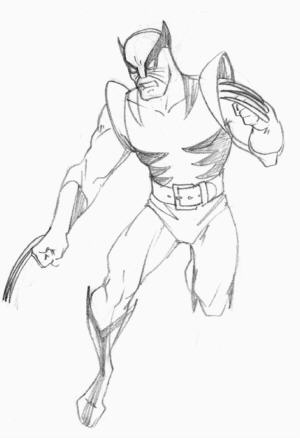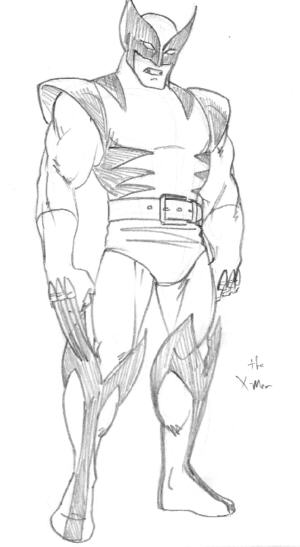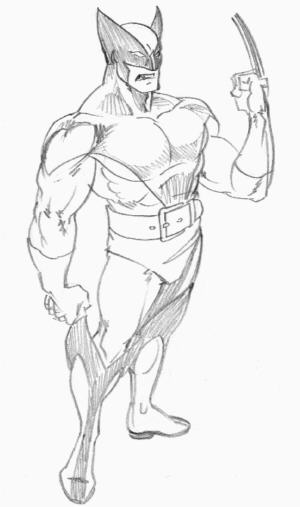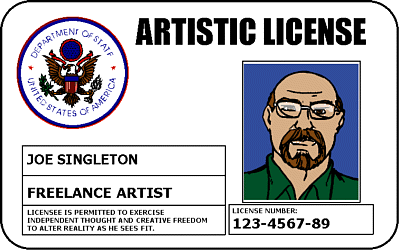|
Wow. A new year, a new century and a new millennium, overnight. I hope this finds everyone well and reasonably happy.
I decided, for this time around, to work with a character that started in utter obscurity and went on to become one of
the most popular characters in comics history. In 1974, in an utterly unremarkable couple of issues of the (somewhat less
than) Incredible Hulk, a new character was introduced. He was first visualized by Marvel Bullpen veteran, John Romita and
was introduced to the world in Hulk #180 and 181, rendered by the able, but unexciting team of Herb Trimpe and Jack Abel,
written by Len Wein (who also crops up, later). In the story, the Hulk has, in his inimitable fashion, managed to find his
way to Canada where he tangles with another man-monster called the Wendigo.
A brief aside here, for those who've never read this stuff. The Wendigo is a cursed creature, a human being who has
resorted to cannibalism, triggering the curse and subsequent transformation into a murderous, hairy, 10-foot-tall monster
driven by hunger for human flesh. At the time the Hulk met it, the Wendigo curse had fallen on one, Paul Cartier, whose
sister, Marie and his former partner, Jean Baptiste, sought to transfer the curse from Cartier to the already-cursed Hulk.
Apparently, the Canadian government takes reports of monsters prowling the north woods, very seriously. So seriously,
in fact, that when they got reports of the Hulk in the vicinity, they sent out one of their newest and most secret assets
to subdue the Green Goliath. Now, you really have to put this into perspective. On one side, there's the Hulk, at 7 feet
and 1,040 lbs (According to the Handbook of the Marvel Universe-First Edition). On the other side, there's the Wendigo,
10 feet and probably 1,500 lbs of slavering hunger and the Canadian government send in their "Weapon X", 5-foot 3-inches
tall and 195 lbs of mutant mayhem. I'm surprised the Hulk and Wendigo didn't just laugh themselves to death.
Don't get me wrong, this little runt would go on to become on of my favorite characters, in years to come. You all
know his name, or names, of course, there's Weapon X, but he's better know to his 2.6 billion fans as Wolverine, Logan
to his friends (or name-droppers). But, in Hulk #180 and 181, he was nobody, and looking like this, is it any wonder?

The Hulk and Wolverine subdued Wendigo and then they fought each other while Cartier's sister, Marie prepared to
remove the curse from her brother. When she used a knockout gas to quell the Hulk and Wolverine, the Hulk transformed
back into Bruce Banner. Upon seeing the helpless Banner, Baptiste refused to continue the ritual to transfer the Wendigo
to him. Marie inadvertently woke Banner while trying to drag him to the cave where the Wendigo lay, and he immediately
transformed back into the Hulk, renewing his battle with Wolverine.
Baptiste went to the cave, himself and completed the ritual, transferring the curse from his friend to himself and
fled the area. The Hulk also escaped, after he knocked Wolverine unconscious.
That was the last we'd see of the diminutive Canuck in yellow and blue. Wolverine re-introduced a concept that had
seemingly fallen out of favor in mainstream comic book characters. While he was still garbed in garish tights, he was
also ARMED. Whatever superpowers he possessed his most prominent and striking feature had to be the metal claws protruding
from his hands. Now, comic companies can be a bit squeamish about such things, at times, which is exactly what happened
in later years, with Wolverine, but for a year or so, in the mid-70s, he was relegated to the file drawer to gather dust.
Then, something extraordinary happened. It didn't seem that way, at the time, but it was the fuse that touched off the
explosion of growth at Marvel in the 1980s. As I recall, the cover date was May 1976, but the seeds of the new X-Men were
being sown as early as late-'74, early-'75.
At that time, the X-Men had been in reprints for a few years and there was talk around the Marvel offices about
reviving the title. The book had been cancelled at what many fans thought was the height of the series, when Roy Thomas,
Neal Adams and Tom Palmer were turning in some stunning work. Apparently, the decision to cancel was based on months-old
sales figures, but whatever the circumstances, it was finally cancelled and went into reprints for several years. By
1973-74, Roy Thomas and Len Wein (see, I told you his name would come up, again) were kicking around the idea of
re-launching the title with a new team. The way they tell it (from interviews in The X-Men Companion, Vol.1, from
Fantagraphics Books, Copyright 1982), it was felt that the old team was economically unviable and that a fresh approach
was needed to make it a success. The idea was to make the X-Men an international team, inspired, in part, by the
Blackhawks. As plans moved forward, and a penciller was sought for the re-launch, Dave Cockrum expressed an interest
in the idea and pitched some of his character designs for the new series. These characters became the core of the new
team, Nightcrawler, Storm, and Colossus. Wein had a character he wanted to use, a "throw-away" guest star from The
Incredible Hulk, Wolverine.
Apparently, though it's not mentioned anywhere I can find it, Dave Cockrum had much the same reaction I did upon
seeing the original Wolverine costume. Now, Dave Cockrum is a classic swashbuckler, at heart, with an obvious love of the
flamboyant. Those puny little "ear-point" and whisker lines had to go and something had to be done with those wimpy
boot-tops. It was Cockrum who molded the sweeping, black wing-shapes of Wolverine's mask and boots. Other artists would
take his design and run with it, in years to come. It was also Cockrum who gave Wolverine his distinctive hairstyle, a
style he had introduced to a similar, "animal-type" character during his run on the Legion of Super-Heroes, at DC,
Timber Wolf.

As it turns out, Cockrum hated Wolverine, for a long time. He had created a character by the same name and resented
the runty, Canadian interloper, somewhat. He also didn't like the yellow and blue costume. In his last issue on the
book (X-Men #107); he gave Wolverine a new costume. The way he did it was fairly interesting. The X-Men had gone off
into space to save the universe (I know, it's mundane stuff, these days, but when this book came out, hardly anybody
had saved the universe, before) and found themselves opposed by a group of super-powered aliens (who didn't see that
one coming?) called the Imperial Guard. These characters were lifted straight out of DC's Legion of Super-Heroes, with
a few visual alterations and new names. It was meant as a tip of the hat to a competitor and it worked remarkably well.
At one point, Wolverine is menacing the Imperial, called Oracle when he is blasted by the flame-wielding Imperial
called Starbolt. As luck would have it, he is relatively unharmed, but his costume is shredded, except for a few
strategically placed scraps which always seem to be super-reinforced in super-hero costumes. Now you know the real
reason why super-heroes wear their underwear on the outside, it's made of an indestructible cloth that's so expensive,
they can only afford to use it to cover the really vital areas. Readers' sensibilities, not to mention the Comics Code
Authority demand it. Well, Wolverine's a scrapper, but he can't very well do any good scrappin' in his shorts, so he
jumps the nearest Imperial, a fur-faced, fanged guy called, Fang (obvious choice, huh?) whom he apparently killed and
stripped. (Fang is listed as deceased in the Handbook of the Marvel Universe) Instant new costume. A black and brown
number, complete with fang accessories and no mask.

The next issue, there's a new artist on the series, who would ride the series to stardom, was John Byrne. At the time he took over the art chores on X-Men, Byrne was working with X-Men writer, Chris Claremont on Iron Fist and Byrne made his opinion of the "Fang" costume abundantly clear in one scene in Iron Fist. The X-Men made a cameo appearance, that issue, having just returned from saving the universe. At the time, X-Man Jean Grey a.k.a. Phoenix was rooming with Iron Fist supporting-cast member Misty Knight, hence the guest appearance. As they burst into the room, Wolverine tears at the alien costume and comments that he can't wait to get out of it. The suit is never seen again and he's back in the yellow and blue for all but Byrne's last few issues on the book.
John Byrne, it seemed to me, really liked Wolverine. He seemed to put a lot of effort into the character's visual development, as well as providing some of the most important elements of Wolverine's background. Before joining the X-Men, Wolverine had been part of Canada's "Alpha Flight", their national super-team, Byrne provided the rest of that team, and eventually leading into a series of it's own, which Byrne wrote and pencilled. Before leaving X-Men, however, Byrne had one final "gift" for the character that he had taken so much care with. The colors reflected a nature, more than his old costume had, the bulk of the outfit was dark brown, the rest a golden tan. The design was effective, if a bit simple.

Wolverine's costume would remain virtually unchanged for several years, until plans for an X-Men animated series led the powers-that-be, at Marvel, to demand a change. It seems the practical brown and gold color scheme just wasn't exciting enough for the marketing people and so Wolverine reverted to the eye-jarring, yellow and blue costume he'd sported in the "old" days. The only exception to this was in the title bearing his name. Much of the time, in his own title, he was seen in street clothes, or as close as approximation of actual clothing as some of the less-talented artists could render. In these stories, he was frequently depicted shirtless and unkempt, almost feral.

After a few years, I lost interest in the character. He became the worst kind of cliche, spouting signature phrases. Utterly predictable. Then came Brian Singer's X-Men movie. I was impressed. Sure, it has been called, "Wolverine and his Amazing Friends", and such, but I really enjoyed it. And one of the things about it that I enjoyed most was Hugh Jackman's portrayal of Wolverine. Yeah, he's too tall and not nearly as hefty as Wolverine appears in comics, but it worked. He was believable. The claws looked very cool, as well. The thing is, in this movie they were able to capture so many of the character traits that made Wolverine popular. He's portrayed as a brawler; he's abrasive and antagonistic with authority figures. Then, when he accidentally injures Rogue, he's genuinely sorry. He shows a sense of humor in his baiting of Cyclops and his flirting with Jean Grey.
When I first started reading X-Men, I was drawn to Wolverine. He was visually interesting, but that wasn't what tugged at my interest. He was unpredictable. He wasn't just another hero in tights. He shredded things with those claws; sometimes those things were people. He had a hair-trigger temper, but when hit in the face with a snowball by Nightcrawler, he didn't react with fury, he challenged the pointy-eared teleporter to a snowball fight. Later in the series, when the orphaned mutant Jubilee joined the X-Men, she found an unexpected friend in the gruff, older Wolverine. I know it's all done by some writers and artists, it's not real people, living real lives, but it's something I look for in comics, books, movies, etc., people, too. When Superman rescues a kitten from a tree, or Batman punches the Joker in the face for the 234,397th time, it's standard. But when a deadly, skilled, and quick-to-anger Wolverine wipes the snow off his grinning face and challenges his attacker to a snowball duel at 20 paces, that's original.
So, what does all this have to do with Artistic License? Well, actually, it's the whole reason I do this thing. I love comics and comic book characters. I like applying my talent and skill to making my own characters and to rethinking existing characters. In this case, it's Wolverine, but in truth, it applies every one that I've done, here.
For my costume design, I brought back some elements from his earlier costumes, and the colors that I think work best for him. Who cares if he blends into the backgrounds, he's a hunter and a tracker; bright, garish colors do not lend themselves to concealment. I used the color scheme of the alien costume, as well as the one John Byrne designed for him, blending some of the elements into the design. The "shoulder pads" blend into the overall design, rather than being tacked on as an afterthought. The mask and boots, while impractical, just look too damn cool to do away with.

While doing the research for this column, I reread the X-Men Companion Vol.1 and that led me to reread the Dark Phoenix Saga trade paperback. Yeah, I got a bit misty-eyed. I'm just a big ol' softy. Well, I have to get busy on next month's column and you need to get on to the rest of the Collector Times. Tell a friend about us. See you next month.
|







